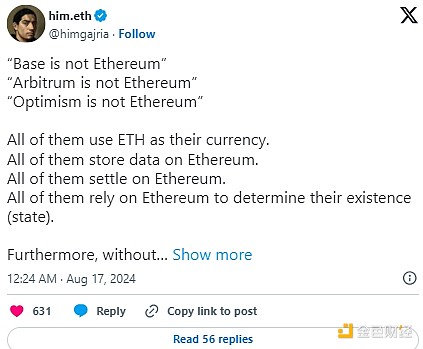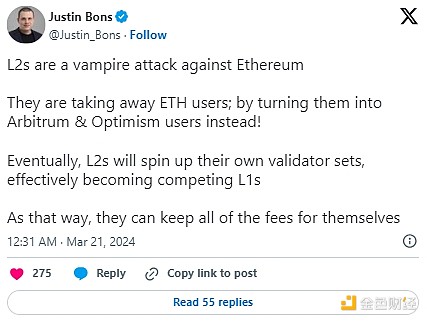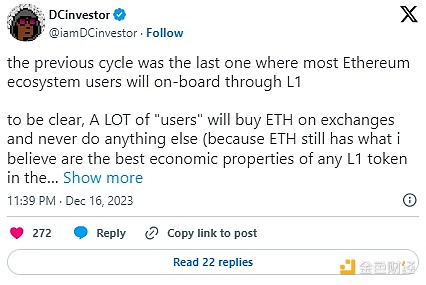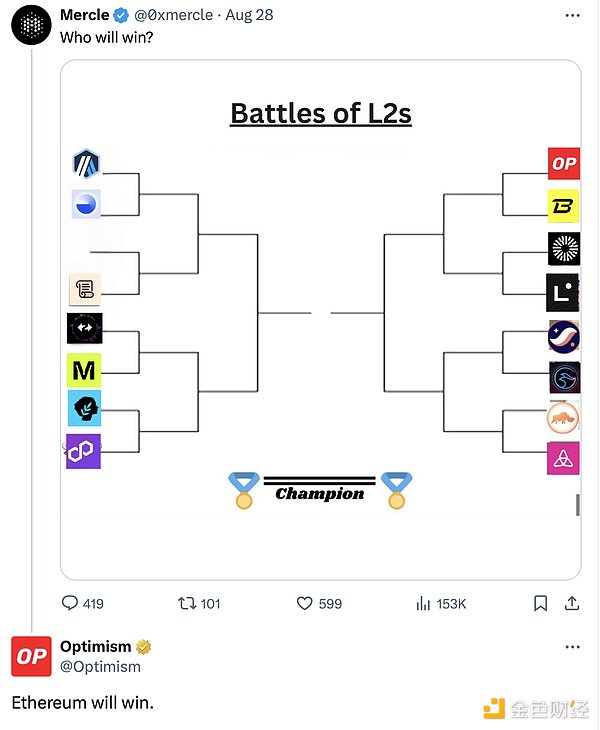Author: Jun, Bankless; Translated by: Deng Tong, Jinse Finance
Ethereum has been in trouble recently.
Sentiment was low, with critics quick to point out that ETH was underperforming SOL, while largely attributing this to L2’s market share and user churn.
This statement raises a crucial debate: Is L2 Ethereum? The answer, like most things in crypto, is a perfect mix of confusion and simplicity. So let’s take a closer look at both sides of this argument and explore the relationship between Ethereum and L2.
Symbiosis or division?
L2s have been a core component of Ethereum’s rollup-centric roadmap since the beginning. They were envisioned as extensions (both technical and cultural) of Ethereum, designed to expand its functionality and appeal to a wider user base.
Essentially, L2 is deeply connected to Ethereum. They share Ethereum's DNA — relying on ETH as currency, benefiting from Ethereum's security guarantees, and using it for data storage and settlement. It's like a startup leveraging its parent company's infrastructure and brand recognition, a win-win for both parties.

The symbiotic relationship between L2s and Ethereum is undeniable. L2s thrive on Ethereum’s infrastructure and security, while Ethereum benefits from increased activity and demand for ETH, making it a better store of value.
By offering lower fees and faster transaction times, L2s make it easier for developers to build different types of applications. Look at the explosive growth of memecoin on Base, or the rise of SocialFi platforms like Farcaster creating new markets for users.
Beyond that, L2s are becoming the main hub for DeFi activity, and the asset ETH is at the heart of this ecosystem. Look at these numbers: Arbitrum, Optimism, Base — these chains are dominated by assets associated with ETH.
Vampire attack?
However, one of the main arguments against the rollup-centric approach to Ethereum scaling is the assumption that L2 may not continue to rely on Ethereum. Sure, L2 and Ethereum look like a happy family right now. But what if L2 builds its own empire and abandons Ethereum completely? No longer relying on Ethereum for security, no longer needing ETH as gas, and not even needing Ethereum's block space.

This “L2 runaway” fear is legitimate. Technically, they could build independent ecosystems with their own validators so they could have the entire modular blockchain stack. So, is this the future — a messy breakup between L2 and Ethereum? Not necessarily.
Creating a new ecosystem or launching another L1 blockchain is a complex and resource-intensive endeavor. Bootstrapping a validator set is a major undertaking, and building a new L1 could result in running into the same scalability challenges Ethereum currently faces. If L2s were going to go down these paths, they would likely have done so from the start.
The secret to splitting?
In contrast, L2 builders are playing a different game. Their main focus is scaling transactions, attracting developers, incentivizing them to build applications for different use cases, and onboarding new users to cryptocurrencies, while Ethereum handles security and decentralization issues.

But that doesn’t mean there aren’t foreseeable problems with the way the L2 landscape evolves. It’s a strange paradox. On the one hand, the proliferation of L2 is a testament to the success of the Rollup-centric roadmap. But on the other hand, it’s a source of division.
We all agree that there are probably too many L2s. Too many imitators. Too little differentiation. It's like a thousand startups chasing the same market, all promising the same thing. That's not healthy.
What we need is L2 that matters. L2 that offers something unique, something different. Security, application diversity, GTM strategy—these are the areas where we need to see real innovation.
Let’s not forget the bigger picture. As Ethereum scales using these L2s, we need to make sure it still feels like Ethereum. We need to avoid falling into the trap of a split, with everyone working in their own direction.
L2 needs to be seamless. Teams are launching technology stacks to develop a unified chain network that shares resources and provides users with a more seamless and faster experience - Superchain, AggLayer, Elastic Chain, Orbit Chains are all promising initiatives in this direction.
But we must be wary of “echo chambers”. These chain zones should not become isolated universes. A healthy L2 ecosystem is one where chains work together, not in isolation. We need bridges, not moats.
We need collaboration. We need communication. We need education. We need motivation. We need to build shared infrastructure and standards to facilitate seamless connectivity between L2s. Only in this way can we truly win together.

Summarize
You can say L2 is not Ethereum. You can argue that L2 is not even an extension of Ethereum. But you can’t deny that L2 enhances the utility of Ethereum and ETH.
The “L2 vs. Ethereum” debate is a false dichotomy. This is not a zero-sum game. Ultimately, Ethereum and L2 are in this together. Let’s build a future where Ethereum and L2 thrive as a symbiotic whole and move the crypto ecosystem forward.







